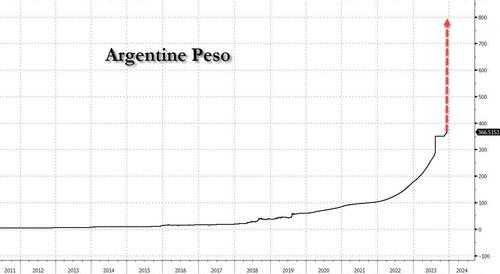(Zero Hedge) How does a modern country climb out of an insurmountable debt hole, especially if it is already in debt to the IMF and a technical default is not an option (especially since said country has already defaulted nine times).
Well, in the case of Argentina which check all of the above boxes, and it has already tried hyperinflation multiple times (like right now for example), the only other option is currency devaluation. Which is precisely what the country’s new president, Javier Milei, announced as the first step of his shock therapy to rescue the insolvent south American nation.
As Bloomberg reports, the new administration weakened the official exchange rate to 800 pesos per dollar, a 54% devaluation, Economy Minister Luis Caputo said in a televised address after the close of local markets on Tuesday. That compares with a 366.5-per-dollar level before the address.
“There is no more money,” Caputo said repeatedly in the recorded video, adding that Argentina needs to solve its “addiction” to fiscal deficits. If only domestic, US addicts to fiscal deficits were watching.
Other measures announced including halving the number of ministries, cutting transfers to provinces and suspending public works. The government will also reduce subsidies on transport and energy sectors, among others. At the same time, Argentina will boost certain social welfare programs, which in a few years time will surely grow to become the biggest fiscal addiction in the country under whoever is president then.
The dramatic first steps follow a somber inauguration speech on Sunday, when Milei warned that Argentines will have to endure months of pain while he works to pull the country from the economic crisis inherited from his predecessor. The devaluation is a necessary step since hyperinflation alone won’t fix the country’s debt problem: inflation is already running at more than 140% annually, and prices are expected to jump between 20% and 40% in the months to come, the president said.
The government had closed Argentina’s export registry Monday, a technical step that often foreshadows a currency devaluation or major policy change. The central bank also announced Monday the official currency market would operate with limited transactions — a restriction it said it will lift on Wednesday.
To be sure, nobody was surprised by the announcement, as a devaluation was long seen as inevitable. In the run-up to Milei’s inauguration, markets were signaling a currency drop of about 27% in the first week of the new government, while investment banks like JPMorgan and local private advisory firms suggested it could weaken about 44% . Grocers had already increased prices and banks were offering sharply weaker retail exchange rates hours before the Tuesday announcement. The question now is how many more times the currency will be devalued, and if Venezuela is any indication of what to expect, the answer is “lots.”
Argentina’s previously administrations had for years slowed the peso’s decline in the official market through currency controls and import restrictions in an attempt to protect dwindling reserves. That hodgepodge of capital controls has spurred at least a dozen exchange rates, hampering business and restricting investment in South America’s second-largest economy. On the campaign trail, Milei pledged to scrap the currency altogether, replacing it with the US dollar, however it now appears that that will be one of the many campaign promises he renegs on.
On Dec. 7, the prior administration had let the peso slip by about 5%, while simultaneously limiting the amount of greenbacks banks could hold in order to prevent them from hoarding dollars. The government had been burning reserves to keep the currency largely steady at 350 per dollar since the August primary vote, when Milei’s surprise showing sent markets into a tailspin. In parallel markets, that rate is about 1,000.







